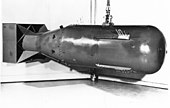
Back ثالوث نووي Arabic Ядзерная трыяда Byelorussian Ядрена триада Bulgarian Jaderná triáda Czech Нуклонсарла триада CV Nukleare Triade German Tríada nuclear Spanish Tuumatriaad Estonian Ydintriadi Finnish Triade nucleare Italian
| Nuclear weapons |
|---|
 |
| Background |
| Nuclear-armed states |
|
A nuclear triad is a three-pronged military force structure of land-based intercontinental ballistic missiles (ICBMs), submarine-launched ballistic missiles (SLBMs), and strategic bombers with nuclear bombs and missiles.[1] Countries build nuclear triads to eliminate an enemy's ability to destroy a nation's nuclear forces in a first-strike attack, which preserves their own ability to launch a second strike and therefore increases their nuclear deterrence.[2][3][4]
Only four countries are known to have the nuclear triad: the United States, Russia, India, and China.[5][6] Israel is suspected to possess a nuclear triad, but its status is not confirmed.
- ^ "Britannica Academic".
- ^ Barry, John (12 December 2009). "Do We Still Need a Nuclear 'Triad'?". Newsweek. Retrieved 8 October 2010.
- ^ Office for the Deputy Assistant to the Secretary of Defense for Nuclear Matters. "Nuclear Stockpile". US Department of Defense. Archived from the original on 28 June 2012. Retrieved 8 October 2010.
{{cite web}}: CS1 maint: bot: original URL status unknown (link) - ^ "Toning Up the Nuclear Triad". Time. 23 September 1985. Archived from the original on 7 March 2008. Retrieved 8 October 2010.
- ^ Mizokami, Kyle (26 November 2021). "How Pakistan Developed Its Own Nuclear Triad". The National Interest. Retrieved 8 July 2023.
- ^ "Babur (Hatf 7)". Missile Threat. Retrieved 8 July 2023.